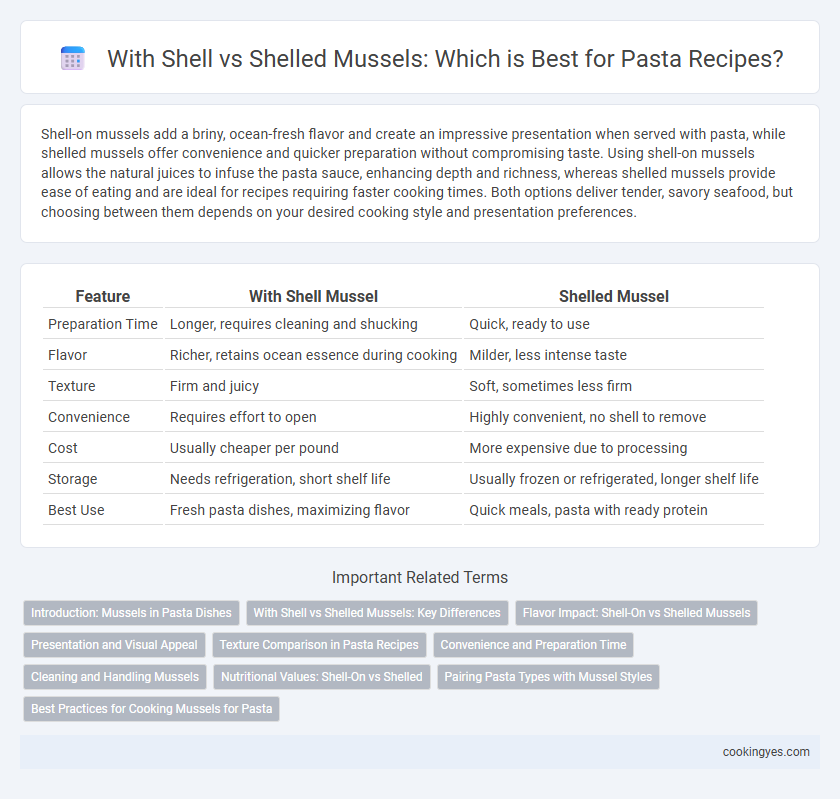Shell-on mussels add a briny, ocean-fresh flavor and create an impressive presentation when served with pasta, while shelled mussels offer convenience and quicker preparation without compromising taste. Using shell-on mussels allows the natural juices to infuse the pasta sauce, enhancing depth and richness, whereas shelled mussels provide ease of eating and are ideal for recipes requiring faster cooking times. Both options deliver tender, savory seafood, but choosing between them depends on your desired cooking style and presentation preferences.
Table of Comparison
| Feature | With Shell Mussel | Shelled Mussel |
|---|---|---|
| Preparation Time | Longer, requires cleaning and shucking | Quick, ready to use |
| Flavor | Richer, retains ocean essence during cooking | Milder, less intense taste |
| Texture | Firm and juicy | Soft, sometimes less firm |
| Convenience | Requires effort to open | Highly convenient, no shell to remove |
| Cost | Usually cheaper per pound | More expensive due to processing |
| Storage | Needs refrigeration, short shelf life | Usually frozen or refrigerated, longer shelf life |
| Best Use | Fresh pasta dishes, maximizing flavor | Quick meals, pasta with ready protein |
Introduction: Mussels in Pasta Dishes
Mussels enhance pasta dishes with their rich, briny flavor and tender texture, providing a seafood depth that complements tomato or cream-based sauces. Using mussels with shells adds visual appeal and helps retain moisture during cooking, while shelled mussels offer convenience and quicker preparation. Selecting between shelled or shell-on mussels depends on the desired presentation and cooking time in traditional Italian pasta recipes like spaghetti alle cozze.
With Shell vs Shelled Mussels: Key Differences
With shell mussels retain their shells during cooking, enhancing flavor and presentation while requiring extra effort to open and clean before consumption. Shelled mussels offer convenience and faster preparation, as the shells are removed, making them ideal for quick pasta dishes without compromising the tender texture. Both forms provide rich sources of protein, omega-3 fatty acids, and essential minerals, but choice depends on cooking style and desired dining experience.
Flavor Impact: Shell-On vs Shelled Mussels
Shell-on mussels infuse pasta dishes with a richer, brinier flavor as the shells release natural juices and minerals during cooking, enhancing the overall taste profile. Shelled mussels offer convenience and quick preparation but tend to deliver a milder, less complex flavor compared to their shell-on counterparts. Choosing shell-on mussels elevates the depth of seafood essence in pasta recipes, making the dish more savory and aromatic.
Presentation and Visual Appeal
Mussels with shell provide a rustic and elegant presentation, enhancing the visual appeal of pasta dishes with their natural, glossy shells and vibrant dark blue or black hues. Shelled mussels offer convenience and a uniform texture, but lack the striking visual contrast that shells add to the plate. Using mussels with shells elevates the dining experience by combining flavor with an attractive, eye-catching display.
Texture Comparison in Pasta Recipes
With shell mussels in pasta provide a firmer, juicier texture as the shells help retain moisture during cooking, enhancing the overall bite. Shelled mussels, meanwhile, offer a softer texture that integrates smoothly into sauces, allowing for an even distribution of flavor throughout the pasta. Choosing shell or shelled mussels depends on whether you prefer a chewy, tactile contrast or a tender, uniform mouthfeel in your pasta dish.
Convenience and Preparation Time
With shell mussels offer a traditional presentation but require extra preparation time, including cleaning and de-bearding before cooking. Shelled mussels provide greater convenience, as they are pre-cooked and ready to use directly in pasta dishes, significantly reducing meal preparation time. Choosing shelled mussels enhances efficiency in the kitchen without compromising the rich, briny flavor essential to seafood pasta recipes.
Cleaning and Handling Mussels
With shell mussels require thorough scrubbing under cold running water to remove debris and must be debearded by pulling out the fibrous threads before cooking, ensuring they are fresh and tightly closed to avoid spoilage. Shelled mussels offer convenience by eliminating the need for cleaning and debearding, making them ready to use but may lack the intense ocean flavor retained in shell-on mussels. Proper handling of with shell mussels involves soaking them in salted water for at least 20 minutes to purge sand and grit, enhancing the texture and taste when used in pasta dishes.
Nutritional Values: Shell-On vs Shelled
Shell-on mussels retain more moisture and natural minerals during cooking, providing higher levels of iron, zinc, and vitamin B12 compared to shelled mussels. Shelled mussels offer convenience and faster preparation but often experience nutrient loss due to exposure and processing. For pasta dishes, shell-on mussels deliver enhanced nutritional benefits and a richer, more robust flavor profile.
Pairing Pasta Types with Mussel Styles
Shell-on mussels bring an intense ocean flavor and an impressive presentation, ideal for robust pasta types like linguine or fettuccine that can hold rich, briny sauces. Shelled mussels, being more delicate and convenient, pair well with lighter pastas such as angel hair or spaghetti, allowing the subtle seafood taste to shine without overwhelming the dish. Choosing the mussel style based on pasta texture enhances the overall mouthfeel and balances the dish's flavor profile.
Best Practices for Cooking Mussels for Pasta
For the best results when cooking mussels for pasta, use fresh mussels with shells to enhance flavor and maintain texture during cooking. Steam the mussels until they open, then remove the shells before mixing with the pasta to avoid shell fragments and ensure even sauce coating. Shelled mussels can be added towards the end of cooking but may lack the depth of flavor that shell-on mussels impart.
With Shell vs Shelled Mussel for Pasta Infographic

 cookingyes.com
cookingyes.com